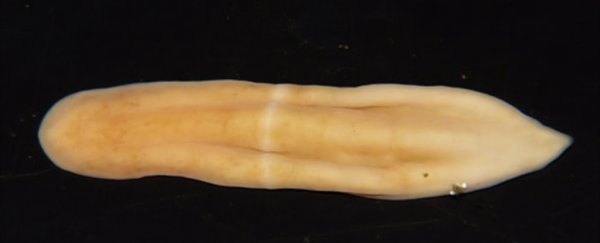Long before we were bipedal mammals with skeletons and brains, we were primitive, sack-like sea creatures with no internal organs, no central nervous systems and no butt - and, somehow, there are still creatures like that living today.
They belong to the mysterious Xenoturbella genus, and now researchers have discovered a sixth species of this strange seafloor-dwelling worm - one that may make the creatures much easier to study.
It's called Xenoturbella japonica, and it was discovered by Japanese researchers from the University of Tsukuba on the seafloor in the western Pacific.
They found two specimens - an adult female about 5 centimetres (2 inches) in length, and a juvenile, about 1 centimetre (0.4 inches). They are orange in colour, with an oval mouth and a glandular network on the bottom surface.
The Xenoturbella genus is genuinely peculiar. It was first discovered in 1915, but not described until 1949: a small, sack-like worm with no organs, no circulatory system, no respiratory system, no gonads and no anus (it expels waste through the same opening with which it eats).
Its position in the animal kingdom was confusing - at one point it was even thought to be a mollusc, because mollusc DNA showed up in a test. But that turned out to be what the worm eats.
Then, in 2016, a team of researchers announced the discovery of four new species of Xenoturbella, found in the eastern Pacific.
With these new additions to the genus, scientists were finally able to place the creatures in the Tree of Life: the basal bilaterian clade of Xenacoelomorpha, containing both Xenoturbella and Acoelomorpha.
It's a very primitive form of bilaterian, the animal group that contains all animals with bilateral symmetry. And it can tell us about how we evolved.
But they tend to live in very deep waters, which makes access quite difficult. This is why X. japonica could be a game-changer - one habitat where it was found is easily accessible from a marine station.
To confirm that it's a new-to-science species, the team used a technique previously not used on Xenoturbella - MicroCT scanning. They found a new feature that hadn't been observed before - a frontal pore connecting to the animal's glandular network, although the purpose of this is unknown.
"We also extracted DNA and sequenced the mitochondrial genome and partial Histone H3 gene sequences," said co-author Hideyuki Miyazawa.
"Molecular phylogenetic analysis confirmed that X. japonica is distinct from previously described species of Xenoturbella."

The other species of Xenoturbella have been divided into two subgroups, "shallow" and "deep". The team discovered that X. japonica had characteristics in common with both.
It was collected at the relatively shallow depth of 380-560 metres (1,250-1,840 feet) like the shallow subgroup, but has a ventral glandular system like the deep subgroup.
Its body length also falls between the two, although it's possible the larger animal had not yet reached its full length.
This suggests that some features may be ancestral and exclusive to the genus, and X. japonica may be the key to figuring out which ones - as well as the history of the genus, and the early history of bilaterians.
"This new species promises to be valuable for future research on bilaterian and deuterostome evolution," said lead author Hiroaki Nakano.
The research has been published in the journal BMC Evolutionary Biology.
